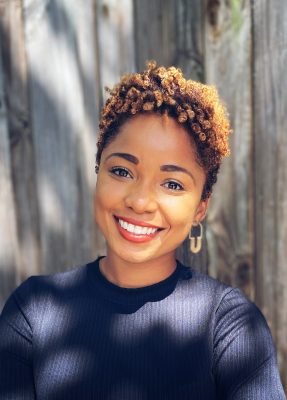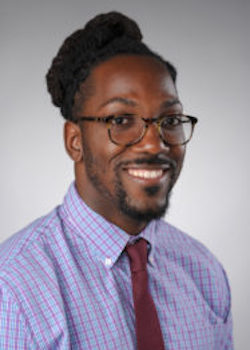In spring 2022, The Study Council at Syracuse University and the Intergroup Dialogue Program collaborated to develop a supportive online community for educators of color across Central New York.

Facilitated by Professor Courtney Mauldin, Assistant Professor of Educational Leadership, and third-year doctoral student Easton Davis G’21, the Educators of Color Dialogue follows a similar framework and pedagogical design adopted by the Intergroup Dialogue Program, developed from the University’s participation in the Multi-University Intergroup Dialogue Research Project.
At Syracuse University, Intergroup Dialogue—directed by Professor Gretchen Lopez—offers academic courses and co-curricular dialogues that focus on race and ethnicity, gender and sexuality, class, and faith-based identities. Each opportunity brings together students and community members from diverse social identities, sometimes with a history of conflict or limited opportunities to engage in meaningful discussion of challenging issues.
The Educators of Color Dialogue also leveraged partnerships formed among the School of Education and multiple Central New York school districts by The Study Council, a research, networking, and support collaboration led by Professor Leela George and East Syracuse-Minoa Central School District Superintendent and School of Education alumna Donna DeSiato G’04.
After signing up for the Educators of Color Dialogue, teachers received a welcome kit, including a journal in which they could process their thoughts and ideas after and between dialogues. They also received the book Creating a Home in Schools: Sustaining Identities for Black, Indigenous, and Teachers of Color, which help to extend the group’s conversations.
“The conversations we held were open and very vulnerable,” says Professor Mauldin. “People showed up as their true selves and had a space to share what they were experiencing in their districts without fear of backlash.”
Easton Davis spoke at length about his experience facilitating the first Educators of Color Dialogue and how this experience informs his doctoral study, which “centers Black bodies and (re)defines well-being.”
“We engaged in dialogue with these educators to acknowledge the challenges of centering their voices and to become attuned to the power and genius they bring to their classrooms.”
Q: How would you describe the Educators of Color Dialogue?

It’s a collaboration between the Study Council and Intergroup Dialog initiatives. We held dialogue sessions between January 24 and May 16, with thirteen participants spread across Syracuse city and area schools. We invited educators with multiple, intersectional identities that ranged in years of teaching experience—from 3 to 17+ years—and various grade levels, including kindergarten, 3rd, 4th, 6th, 9th, and 12th grades.
Professor Mauldin and I worked to create an affinity space for these teachers so we could engage in dialogue around topics such as social equity in schools and develop resources to affirm educators of color experiences.
Q: In Intergroup Dialogue, trained facilitators frame co-learning, encourage open discussion, and guide a group process designed to build trust and explore intersections. Does the Educators of Dialogue follow this process?
The Educators of Color Dialogue follows a similar process and structure used to sustain dialogue; however, our dialogue was co-facilitated by two individuals who identify with members of a similar or shared racial and ethnic identity groups—Black, African American, or Latinx.
The content and curriculum were based on the educators’ interests. We created an overview of various topics, including the history of teachers of color, exploring social identities, naming conflict, and establishing a community of care for students and educators.
Most intentional in bringing together these educators of color was centering our perspective in healing. Part of our intention was rooted in a healing justice approach, given the current social and political climate and what teachers of color experience, including often being one of few in a majority White profession and feeling burned out because of the pandemic and social uprisings spurred in 2020.
That’s why we centered what healing looks like or feels like—affirming their experiences as enough, while also acknowledging larger systems of inequality and oppression.
Q: Could you expand on what you mean by “larger systems of inequality and oppression” in this context?
Our group sometimes discussed how larger systems of oppression such as racism, sexism, and homophobia are reinforced within institutions such as education, especially for educators of color.
We acknowledged how these systems of oppression manifested within our thoughts, policies, and larger school systems, such as the over-policing of Black children, stereotypes, and racial microaggressions towards Black, Asian, and Latinx educators, such as name-calling and bullying.
Aspects of our dialogue also touched on the practice of self-care as an act of embracing joy, when reflecting how larger systems of oppression often perpetuate issues of social inequality and racial injustice in schools.
Q: How would you describe the goals of the dialogue?
Our goal was to be present to the needs and desires of educators and be mindful of their experiences as educators of color.
It is important to note that although the climate and culture within school districts for some might be described as exhausting and insensitive to educators’ needs for support, we co-created a space to discuss how advocating for joy and imagining acts of radical care during a moment of intense inequity, violence, and precarity is critical to our survival and sense of thriving.
Professor Mauldin and I are not trying to act as though there is a panacea to fix what is wrong in the world. We engaged in dialogue with these educators to acknowledge the challenges of centering their voices and to become attuned to the power and genius they bring to their classrooms.
Q: What feedback did you get back from the participants?
The teachers appreciated our vulnerability modeling activities and valued the space. The tools we offered were prompted from issues that the teachers themselves raised. We used this self-guidance to develop session topics and content and to help contextualize issues that were raised.
Q: Will this work inform your doctoral research?
Yes, my work and support with the Educators of Color Dialogue will undoubtedly continue to inform my work and dissertation topic, especially as I continue to understand the relationship between emotions and healing justice.
This dialogue occurred during a time of profound racial injustices, precarity, and inequality—anti-Black and anti-Asian racism, transphobia, homophobic policies, and legislation, most notably within schools across the country. It is essential to create spaces, particularly for educators of color, in which to talk about challenges and issues of inequity that they experience as one of few persons of color across districts.
However, this is not the only aspect of dialogue that I find significant to my approach to healing justice for people of color. I interpret healing justice within dialogues that explore issues of social inequality as both an acknowledgment of historical oppression and its manifestations and an opportunity to discuss what reclaiming might look and feel like in the body.
For me, this exploration necessitates an approach to dialogue that affirms lived experiences as enough and encourages folks to play and have fun in the process. Remembering how a negative experience affected a person’s sense of self and identity might evoke myriad emotions, but it also can become an invitation to center practices of joy and love.
